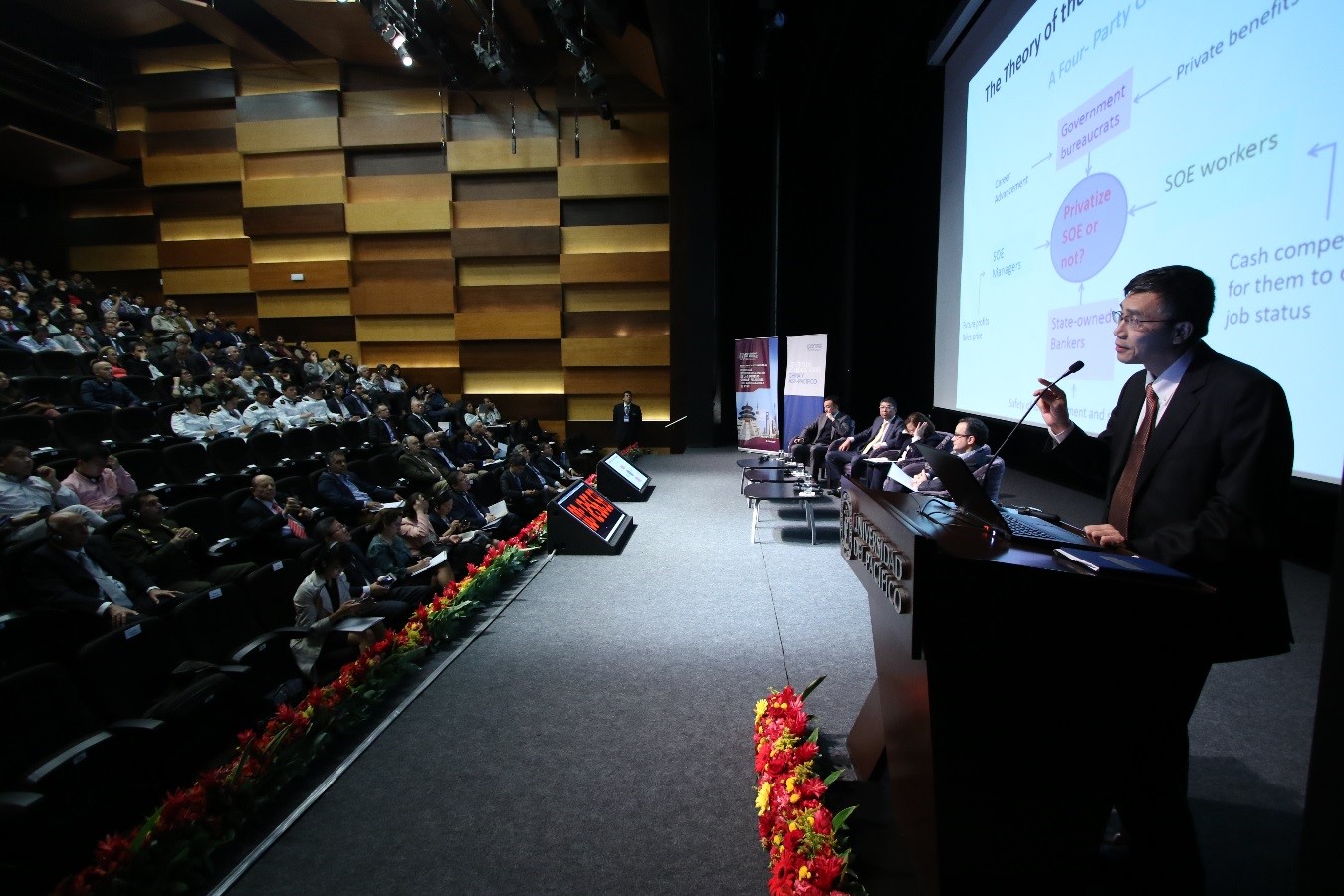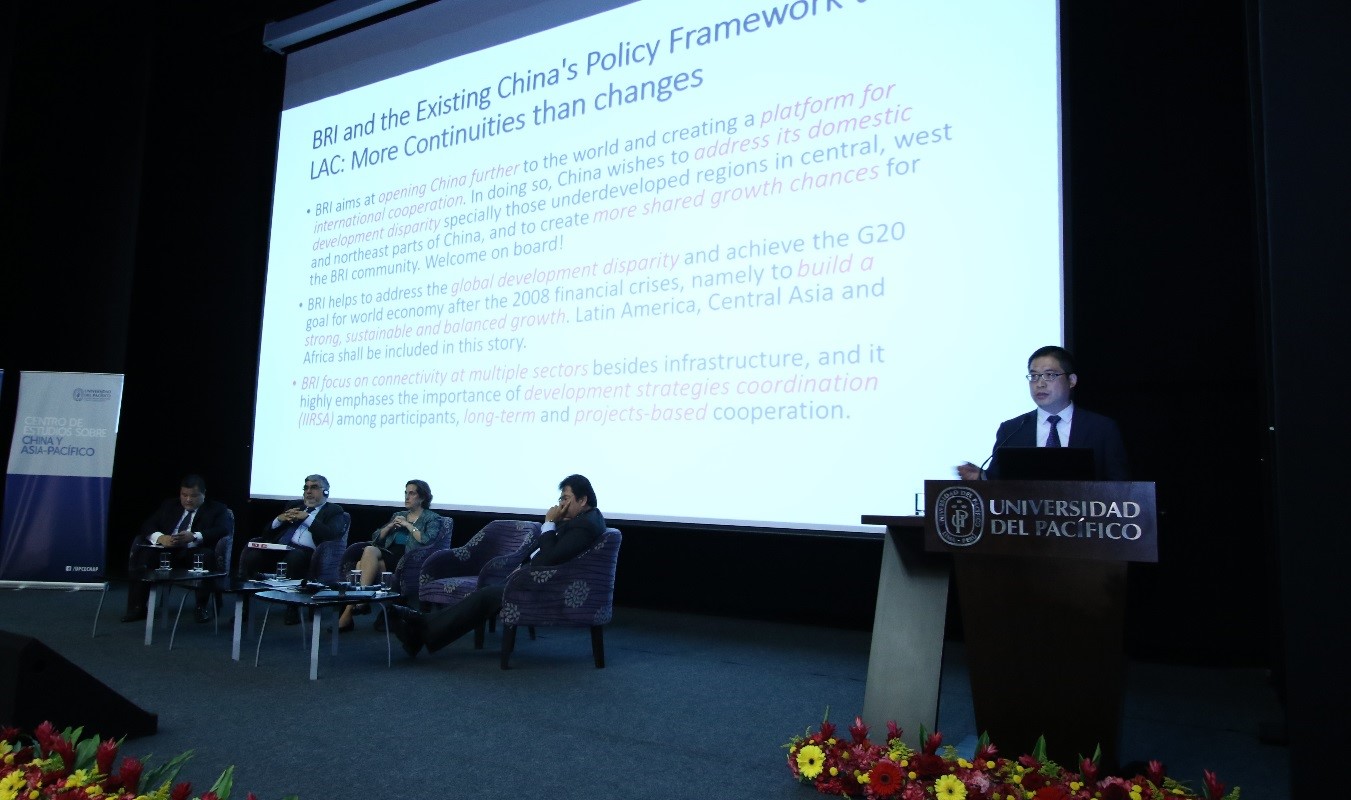In this framework, Universidad del Pacífico Center for China and Asia-Pacific Studies organized the international conference: "Reform and internationalization of Chinese companies and relations with Latin America and Peru", held on December 6. The event featured the presentations of two Chinese experts especially invited for this conference. The discussion panels were completed by local experts from the Peruvian government, the national private sector and academia, as well as representatives of Chinese companies operating in Peru, the latter thanks to the collaboration of the Association of Chinese Companies in Peru.
Before starting the thematic discussions, the welcome words were in charge of Dr. Elsa Del Castillo, President of Universidad del Pacífico, Mr. Kong Aimin, President of the Association of Chinese Companies in Peru, and Ms. Hao Qinmei, Economic and Commercial Counselor of the Embassy of the People's Republic of China in Peru.
Deep reforms in Chinese state-owned enterprises
The session on “Chinese Companies: Reform, Development and Internationalization”, had as main speaker Dr. Liu Guy Shaojia, Ph.D. in Economics from Oxford University, specializing in industrial economics with an emphasis on reform and development of Chinese companies, Senior Professor and Head of the United Kingdom Campus, Peking University HSBC Business School.

Dr. Liu, Guy Shaojia and the panel of the first session of the conference
Dr. Liu explained that the Chinese economy has gone through three economic cycles in the last 40 years, which are related to the four waves of state-owned enterprises reforms. The first two waves basically consisted of measures that sought to increase productivity. In the first, performance bonuses were implemented for management and workers, while in the second, a system of contractual responsibility was established for the delivery of good results.
The following reforms incorporated a series of measures for restructuring state-owned enterprises. The third wave introduced measures such as: restructuring of corporate governance; privatization of small and medium state-owned enterprises, keeping control of large companies; and flexibilization of the labor regime allowing the dismissal of workers. Finally, the fourth and current wave of reforms consists in reducing the concentration of state ownership by introducing "mixed ownership" or partial privatization. Moreover, the surplus capacity of the companies has been cut. The reforms also include the reorganization of corporate governance, the drive for internationalization, and the introduction of anti-corruption campaigns.
The reform of Chinese state-owned enterprises has generated good results. Of the 500 largest companies in the world, 76 are Chinese state-owned companies. Regarding internationalization, Chinese investment is present in most countries of the world. In Peru, for example, there are about 170 Chinese companies between state-owned and private.
However, according to Dr. Liu, China still has some important challenges in this area, the main ones being: the fight against corruption, the economic losses that some state-owned enterprises have, the low productivity, and the pollution of the environment that is associated with their operation in several sectors. The reform policies of China's state-owned enterprises are focused on overcoming these challenges, which will lead to a new cycle of economic growth rates acceleration.
Chinese companies in Peru in non-extractive sectors
As the panelist, Mr. Huang Jianrong, President and General Manager of China Communications Construction Company (CCCC) in Peru, highlighted, his company is a good example of the successful reform of Chinese companies. CCCC is a provider of infrastructure construction services worldwide, founded in 2006 through reconstruction in the form of a new creation, reorganization and merger of large central state companies. In the latest update of the Fortune Global 500 ranking, CCCC occupies the 103rd position. In the Top 250 International Contractors ranking (Engineering News Record, ENR) ranks first in Asia and third in the world.
The construction company has carried out important projects, such as the Hong Kong - Zhuhai - Macao Bridge, the longest sea bridge in the world. Currently, the company is located in 109 countries. CCCC formally incorporated its branch in Peru in 2013. During these 4 years of research and development, CCCC has become an active participant in the Peruvian infrastructure construction market. For example, they have submitted proposals for La Joya Regional Highway - Arequipa and Puerto San Juan de Marcona projects.
On the other hand, Mr. Huang Yongjin, Deputy General Manager of Huawei Peru, highlighted that last year, the company reached the 83rd position in the Fortune Global 500. In addition, Huawei has a presence in more than 170 countries. The company began operating in Peru in 2002, being the first to develop the 3G and 4G networks in the country. In addition, as pointed out by Mr. Huang, Huawei is responsible for about 80% of the communications technology with cell phones in Peru, not only in terms of the phones themselves, but also the technology behind them, such as optical networks, wireless, IP and broadband.
The Huawei representative said that the company is studying the possibility of implementing a direct submarine cable connection from South America to China to optimize communication with the Asia-Pacific region. Due to its geographical position, Peru would be the best location for the connection point in South America. The project would merit further studies as it would position the country as a communications center in the region and could generate significant revenues a year by renting the network to other countries.
Finally, according to Professor Vicente León, Associate Dean of the School of Economics and Finance at Universidad del Pacífico, the Hong Kong and Shanghai Banking Corporation (HSBC) has positioned itself in the Peruvian market to support mining companies in major operations. However, while it is true that Chinese investment has traditionally focused on the extractive sector, particularly mining, it is in the process of diversification. Professor León pointed out, for example, the Chinese investments that are being directed to other key sectors of the Peruvian economy, such as energy, as is the case of the purchase of the Chaglla hydroelectric plant.
New opportunities for China's relations with Latin America
During the session on "Relations between China, Latin America and Peru: Trends and Challenges", Dr. Niu Haibin, Ph.D. in International Relations from Fudan University, Senior Fellow, Deputy Director of the Center for American Studies, and Assistant Director of the Institute for International Strategic Studies of the Shanghai Institutes for International Studies, participated as keynote speaker.

Dr. Niu Haibin and the panel of the second session of the conference
Dr. Niu stated that China shares the concerns and challenges of developing countries because it is still a middle-income economy, like most Latin American countries, which allows it to get closer to them. Therefore, it is possible to build a new type of relationship with Latin America based on common development.
Examples such as the two policy documents on Latin America in 2008 and 2016, the "1+3+6" (2014) and "3x3" (2015) cooperation plans, the creation of the China-CELAC Forum (2014), the free trade agreements with Chile, Peru and Costa Rica, and the comprehensive agreements with some Latin American countries (which consider issues beyond purely commercial ones), are part of the strategy and show the greatest relevance that Latin America is having for the Chinese foreign policy.
Also, trends and changes in the Chinese economy represent new opportunities for economic growth and development in Latin America. On the one hand, China has managed to become one of the leading exporters of direct investment in the world and is also in a process of economic transition from being the world's factory to becoming a global innovation center. On the other, unlike the positions expressed by the United States, China has reaffirmed its commitment to openness and the process of economic globalization.
According to Dr. Niu, this commitment is expressed in initiatives such as the Belt and Road Initiative (BRI), which focuses on developing connectivity through investment in infrastructure and other sectors, and the creation of new regional and multilateral funding sources, such as the Asian Infrastructure Investment Bank (AIIB) and the New Development Bank (NDB).
How Peru can take advantage
The guest panelists were in charge of examining how Peru can take advantage of the opportunities opened by China. In the first place, Mr. Luis Torres, Director of Export Promotion at the Peruvian Export and Tourism Promotion Commission (PromPerú), stressed that the relationship with China is based on a State policy. This perspective was adopted twenty years ago. One of the main pillars of the relationship is the Free Trade Agreement that has been in force since March 2010. He also highlighted successful experiences and strategies of Peruvian companies and brands (such as the cases of "Alpaca Peru" and "Superfoods Peru"), which contribute to a greater penetration and knowledge of the Chinese market.
Ambassador José Antonio Bellina, General Director of Asia and Oceania at the Ministry of Foreign Affairs, highlighted the existence of important mechanisms to take advantage of the relationship between Peru and China. For example, Peru has a Free Trade Agreement, a Comprehensive Strategic Partnership and a Joint Action Plan (that considers the 2016-2021 period) with China. These agreements form the basis of the bilateral relationship and place Peru in an important position in the Latin American region. Also, in relation to the BRI, due to its importance, Ambassador Bellina stressed that the Ministry of Foreign Affairs is evaluating this initiative and a first document is being prepared to be shared with all sectors.
Mr. José Tam, President of the Peru-China Chamber of Commerce, agreed that it is important to define a strategy to take advantage of the BRI opportunities. On the other hand, in order to facilitate trade, he suggested examining the possibility of using the RMB in exchanges. Greater associativity of SMEs that lack both preparation for exporting as well as supply capacity to meet the Chinese demand should also be encouraged. Maybe they should start by meeting the demand of smaller Chinese cities, he said. On the other hand, it would be convenient to take advantage of the experimental free trade zones created in China to encourage Latin American trade, as is the case of Zhuhai.
To sum up, as Dr. Rosario Santa Gadea, Director of Universidad del Pacífico Center for China and Asia-Pacific Studies, pointed out, in order to define an effective relationship strategy with China, it is necessary to understand the transformation processes of its economy and its companies. The trends in China's relations with Latin America are not detached from these transformation processes, he said. So, we must study them, with the perspective of identifying the areas with the best potential to relate to China as well as the instruments that we can best use to achieve this purpose. In his opinion, it is about thinking, with a long-term perspective, about how the relationship with China can contribute to achieving Peru’s development objectives. One of these ways is to look beyond trade in order to focus on investment for productive development.
This international conference brought elements that may be useful for future reflections on this perspective.